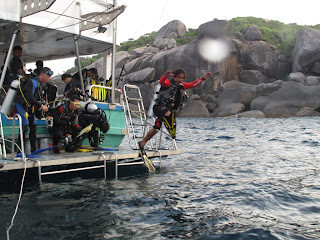
I went diving with a friend today who is a newly certified as a diver. After three dives, she handed me back the regulator and forgot to cap back on the ScubaPro MK25 first stage which also my mistake for not checking the equipment before soaking the gears which incliding the regs, lights, camera, computers and etc. After a short soak, I took the gears out and hang dry and just before I hanged my reg I discovered the reg of my buddy was using was completely flooded due to being submerged without the cap on.
I was pretty beside myself at first, since every instruction books I have ever read about equipment always specifies that you are not supposed to ever get water in the first stage. I quickly did a web search like now, read through my diving encyclopedia and other PADI manuals to see what I could do about it. Did I need to send it in for service, overhaul, or replacing damaged parts? Should I have just let it dry out? I was not able to find the answers anywhere. All I could find was the same old “Don’t ever get water in the first stage” warning.
Therefore, I called the regulator specialist just now and talked it over with him. The good news was, that there something I could do to reduce the damage to this pricey piece of equipment. I wanted to share this experience with other divers so that people can know what to do if you should accidentally flood the 1st stage of your regulator.
Here are the basics:
•It’s not that bad if you flood it with fresh water. If your regulator is flooded with salt water, rinse with fresh water immediately, to avoid corrosion.
•The main thing that you want to avoid is pressurizing the regulator while there is water inside and a computer or SPG attached. This could potentially damage your instruments downstream. It may be necessary to leave your second stage regulator attached.
What to do:
1.Immediately remove all hoses and high-pressure ports, leaving only the second stage regulators attached to the low-pressure portion of your 1st stage.
2.Rinse with fresh water if necessary (i.e., if you suspect that you have salt water or other contaminants inside the first stage).
3.Attach the first stage to a tank and turn on the air. You will be flushing all water out the high-pressure ports. You can then slowly purge the second stage regulator so that any water in the hoses will pushed out of the system. (Warning: don’t ever pressurize a 1st stage regulator on a tank without a way to depressurize, such as having a second stage attached or a port open. If you do, good luck ever getting that thing off).
4.Take your computer/SPG and hold it with by the terminal end and give it a good twirling to get any residual moisture or liquid out. It is very unlikely that you got any water through the pinprick-sized hole if you didn’t pressurize the system wet, but this is just for good measure.
5.Last, if you are in a reasonably non-humid environment, let the whole thing sit out with ports out for a few hours to let any moisture evaporate before reassembling the regulator.
Well, I hope this page helps you out if you are unfortunate enough to have flooded your first stage regulator. Remember, I got off lucky because I didn’t pressurize the system with the console attached and this is fresh water we’re talking about. What I’ve described here is just the immediate remedy to avoid and/or mitigate the damage done by flooding, most of which is corrosion. I’m not an expert, so please take into consideration that your situation may vary depending on what type of water you got into your regulator and the type of regulator you have (mine is a piston design). You should definitely still bring your regulator into your local dive shop to have them take a look at it, even after following this procedure. Regulators are expensive and sophisticated pieces of gear that our lives depend on, so it’s better to be safe than sorry.














































